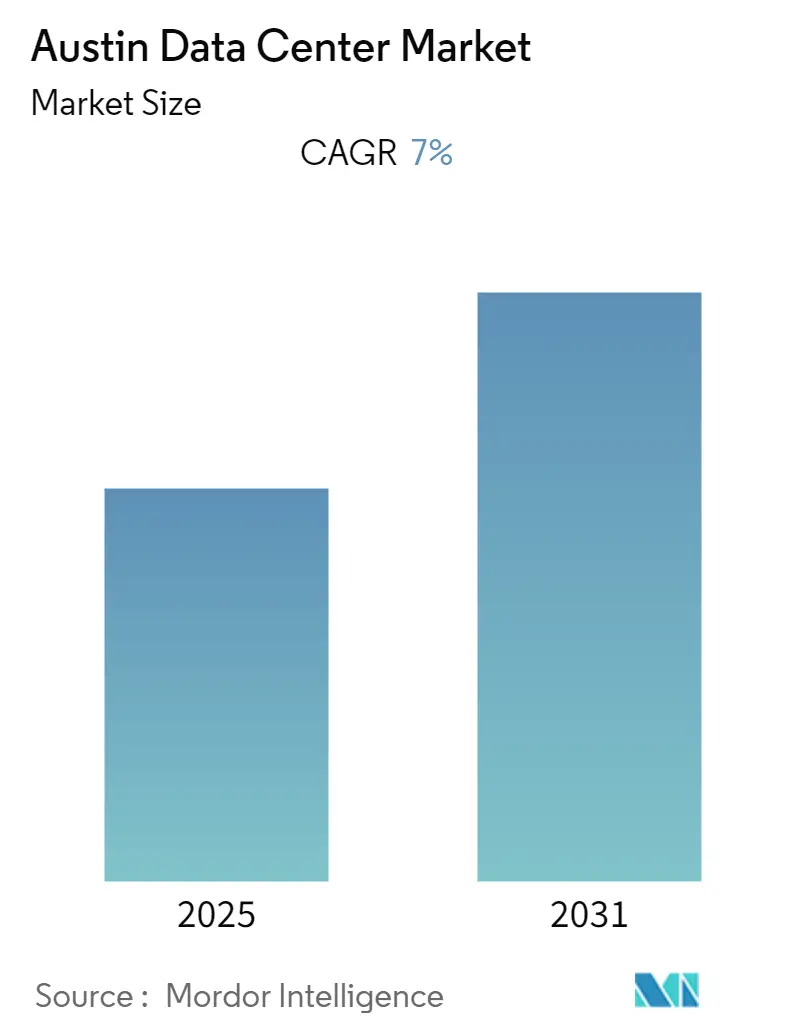
| Study Period | 2019 - 2031 |
| Base Year For Estimation | 2024 |
| Forecast Data Period | 2025 - 2031 |
| Historical Data Period | 2019 - 2023 |
| CAGR | 7.00 % |
| Market Concentration | High |
Major Players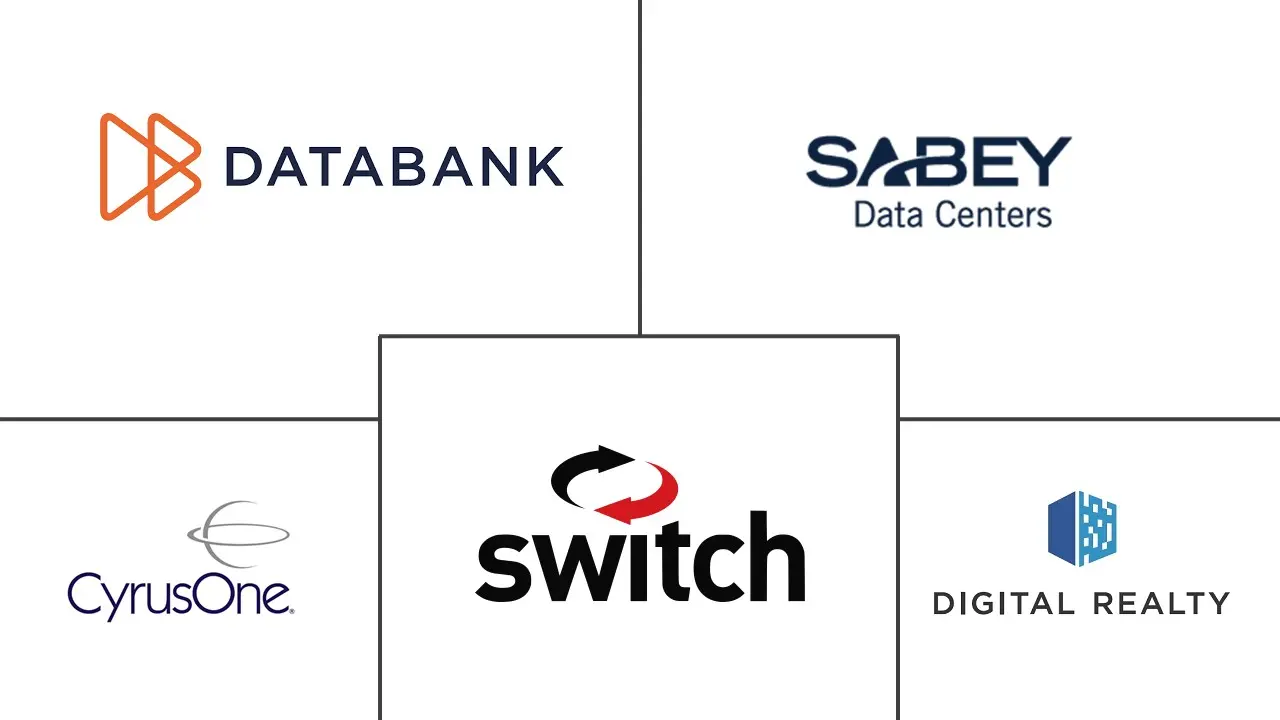
*Disclaimer: Major Players sorted in no particular order |
Austin Data Center Market Analysis
The Austin Data Center Market is expected to register a CAGR of 7% during the forecast period.
- Artificial intelligence (AI) with machine learning (ML) necessitates the development of brand-new data center infrastructure more than any other application. Artificial intelligence (AI) and machine learning (ML) may require three times the power density of traditional data processing, necessitating a revolution in data center architecture. This is also dependent on sophisticated cooling systems to support the larger output. The intense nature of AI and ML computations may also result in a significant dispersion of computational, memory, and storage resources among many processors in a computational cluster.
- The developments that are happening toward the data power will drive the studied market. For instance, in April 2022, Austin Commercial, a division of Austin Industries and one of the country's most diverse builders, announced an enterprise collaboration with Versatile. This construction technology pioneer uses artificial intelligence (AI) and the Internet of Things (IoT) to optimize building processes. Versatile's CraneView, which automatically collects and analyses productivity data from construction sites, is the first to be employed by a Texas-based general contractor.
- A data center must adhere to the following specification to be defined as a Tier III facility. The facility should offer N+1 (the amount required for operation plus a backup) fault tolerance. Also, the Tier III facility providers can undergo routine maintenance without a hiccup in the overall operations. However, unplanned maintenance and emergencies may cause problems affecting the system. These problems may potentially affect customer-facing operations.
- These data center facilities provide a 99.982% uptime. The companies using these Tier III facilities are often growing companies or businesses that are considerably larger than the average SMBs (Small to Medium Businesses). These Tier III facilities also offer most of the features of a Tier IV infrastructure facility without some elite protection. For instance, enterprises can leverage the advantage of dual power sources and redundant cooling as the network streams are fully backed up.
- On the flip side, the country's commercial real estate has been constantly evolving and changing due to the continued integration of technology at all levels of the industry and across all property types. As more companies have been transitioning toward cloud computing with major vendors expanding their capacities has been influencing land prices; for instance, Amazon Web Services (AWS) currently has cloud infrastructure in 22 regions and has predicted that new data centers may be needed in hundreds of regions to keep up with demand.
- According to North American Data Centers Report, the strong leasing activity during the second quarter of the pandemic stemmed from hyperscale companies, as many of these tenants pulled forward their requirements due to the distributed workforce and the work-from-home lifestyle. In addition to remote work, online gaming, social media, video streaming, and e-commerce drove leasing activity during the pandemic. Colocation service providers and cloud have been benefactors of rising SaaS and network customer demand from the pandemic response necessitating remote working and educating. In addition, these services are particularly recession-resistant, and demand for services has been increasing, translating to data center construction projects remaining in progress to ensure they could meet demand.
Austin Data Center Market Trends
Tier 4 is Expected to Hold Significant Share of the Market
- A Tier-IV data center represents the other end of the range. This tier promises its customers uptime, 2N (two times the quantity needed for operation) cooling, and redundant infrastructure and electricity. These rules could safeguard most companies. Level IV customers hardly ever learn about problems with the data center infrastructures because of these redundancies. These tests serve as a testament to the dependability of top-tier systems. Several independent and physically separate systems act as redundant capacity components and distribution routes in this data center. Separation is necessary to avoid harm from being done to both procedures by a single event. Unexpected or planned disturbances may not have an impact on the ecosystem. The environment may be more susceptible to disruption if a failure happens if redundant components or distribution pathways are closed for repair.
- Tier-IV data centers are called "fault-tolerant." Unplanned maintenance does not affect data flow to a Tier-IV data center. Day-to-day operations continue regardless of whether or not assistance is provided. Mega companies frequently select Tier-IV data centers, outperforming all three tiers outlined above. The uptime rates can reach 99.995%, implying that the data center may only have 0.5 hours of downtime annually. A Tier-IV data center also has 96-hour power outage protection and multiple redundancies to ensure the system can continue operating even if significant components fail.
- Tier-IV facilities increase the failure tolerance of the Tier-III topology. IT operations will be unaffected if equipment fails or the distribution path is disrupted. All IT equipment must have a fault-tolerant power design to be interoperable. Continuous cooling is also required in Tier-IV data centers to maintain a stable environment. While the redundancy required to operate and maintain a Tier-IV data center is frequently prohibitively expensive, companies with the resources to reap the benefits of improved performance and dependability do so without hesitation. Government agencies often operate their data centers by Tier-IV data center standards.
- One of the primary drivers driving demand for data center systems and technology, propelling the market growth, is the rising cloud technology in data centers. Cloud technology is more adaptable because it can be accessed from various devices, and data may be recovered quickly. On the other hand, cloud computing provides fast speed, which aids the growth of other firms.
- According to US Census Bureau, a rise in the sales value of smartphones sold in the United States of USD 1.7 billion in 2022, for a total of USD 74.7 billion in sales in 2022. data center use for smartphones. Data centers are a critical part of the infrastructure that enables smartphones and other mobile devices. Data centers provide the storage, processing, and networking capabilities that enable the transmission and processing of the vast amounts of data that are generated by mobile devices. Such a huge rise in the sales of smartphones would drive the market.
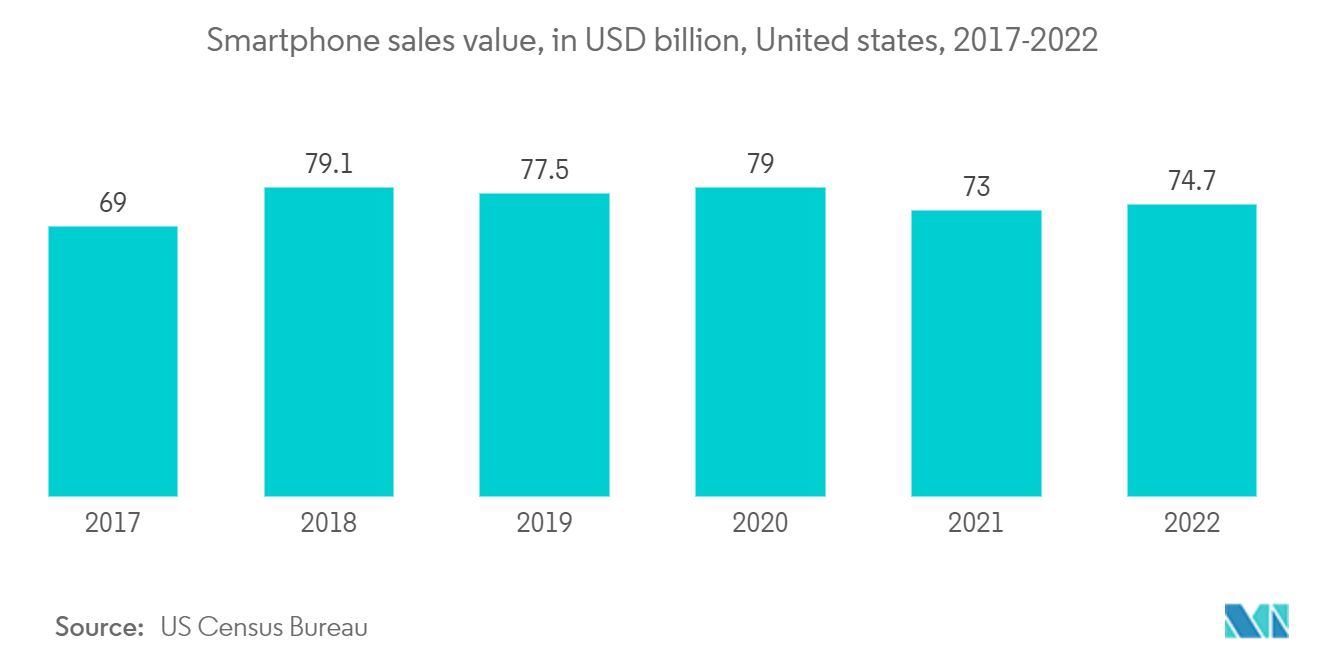
Retail Colocation Center is Expected to Hold Significant Share
- Retail colocation is where the customer takes the space for lease within the data center, such as rack space within the caged-off area. Owing to various advantages, such as economics and ease of maintenance, smaller enterprises generally prefer retail colocation. Owning a data center is not a viable option due to the cost of land leasing. Also, maintenance of a colocation center is often not within budget constraints.
- The retail colocation market is likely driven by the high demand for colocation services from developing countries. Compared to wholesale colocation services, retail colocation services are highly suitable for enterprises requiring lesser computing power at one site or across multiple locations to benefit local and global customers. The retail colocation market is anticipated to grow significantly during the forecast period. About 100 kW of energy is typically needed to power retail data centers, while wholesale customers usually need more than 100 kW, owing to their business scale. Many facilities, such as security provision, customer support, cooling facilities, etc., are provided by colocation suppliers.
- Typically, retail customers have many partners to maintain connectivity. Therefore, a diverse set of carriers with good speeds are necessary. Additionally, as retail data center providers work with more clients than wholesale providers, their facilities usually offer a multitude of networks and services. Retail providers offer various services, such as smart hands and remote hands, for technical assistance, managed services, and network monitoring. Therefore, resolving issues can be as simple as raising a service ticket. Such services help exploit various other benefits, such as locating data centers away from disaster-prone areas that can be remotely operated. Due to this remote hand's technology, tax benefits in different states can be used to avail certain tax benefits.
- Many new technologies, including 100% green data centers, have been deployed in retail colocation. In July 2022, Sabey Data Centres, a provider of colocation data centers, today announced the start of construction of a new 40-acre data center campus in Round Rock, Texas. The new campus will have a power capacity of up to 72 megawatts (MW). The need for interconnectivity is also increasing, increasing the demand for retail colocation. It has been identified that the leading providers of colocation services offer as many as 230,000 interconnection possibilities. Many SME industries constitute a large part of the economy. Such SMEs cannot afford an entire space only for utility, as the IT staff and operations are included in this scale of operation.
- According to SurfShark, in 2022, the United States E-infrastructure index amounted to 0.1944. By contrast, the Internet affordability index was only 0.0326. Since retail colocation facilities have become old and outdated, their customers are choosing to leave these facilities to find other, newer, multi-tenant data center providers. When retail colocation facilities lose customers, this presents itself in their customer churn metrics. Indeed, public data center companies report churn metrics quarterly, with higher churn implying that more customers are leaving.
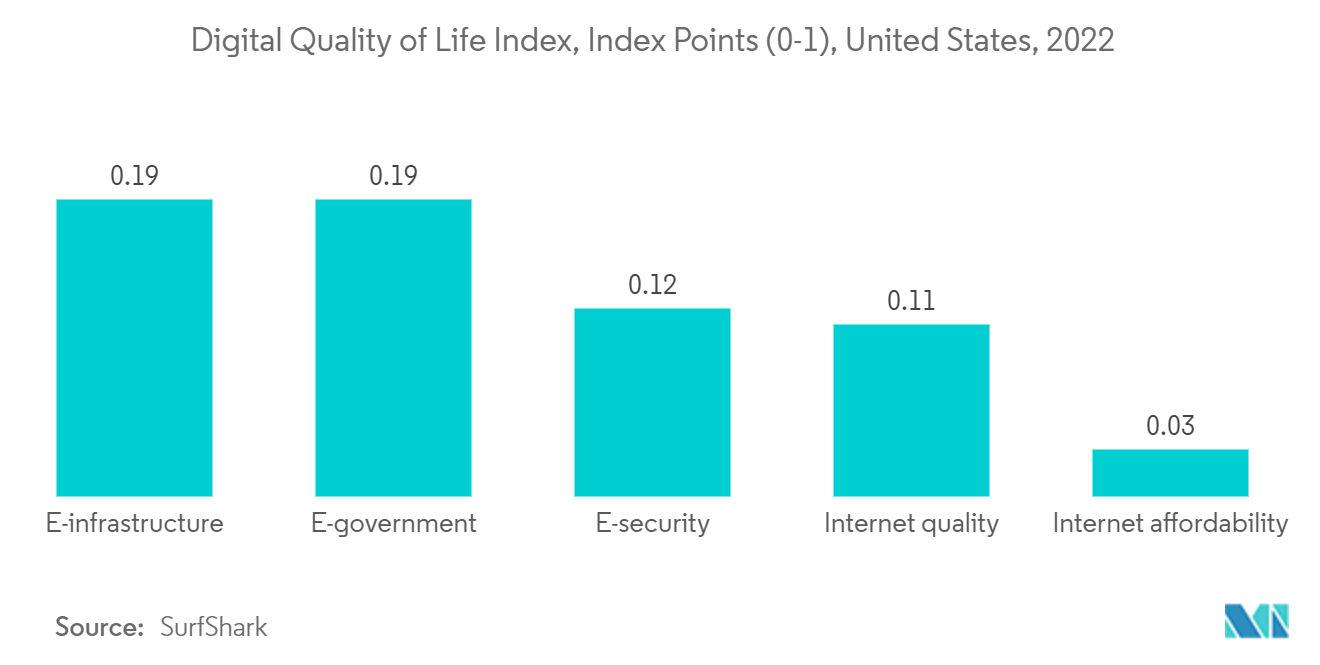
Austin Data Center Industry Overview
The Austin Data Center market is consolidated with the presence of major players like Digital Realty Trust, Inc., DataBank, CyrusOne, Switch incetc. The companies continuously invest in strategic partnerships and product developments to gain substantial market share. Some of the recent developments in the market are:
- In May 2023, Skybox Datacenters and real estate developer Prologis are collaborating to build a massive data center facility in Austin, Texas. Skybox, as first reported by Data Centre Frontier (DCF), has revealed plans for PowerCampus Austin, a 600MW facility spread across 160 acres in northeast Austin's Hutto neighborhood. In collaboration with logistics real estate company Prologis, the facility could house up to four million square feet (371,600 square meters) of data center space. Two 300MW private substations would be built on the property. Skybox and Prologis want to construct 6 to 8 buildings with data centers ranging from 24 to 48MW. The 72MW concept envisions a three-story, 700,000 sq ft (65,000 sqm) structure.
- In September 2022, Logix Fibre Networks has agreed to construct fiber into Sabey Data Centres' new Round Rock data center facility. Logix has announced a capital commitment of USD100 million for 5G growth initiatives and network modernization. Sabey data center tenants will have more connectivity options across Texas due to Logix's network of 295,000+ fiber miles and 100+ on-net data centers. Logix's new offering at Sabey's data center delivers connectivity and extended interconnection opportunities closer to where businesses work in Austin, Texas, and beyond.
Austin Data Center Market Leaders
-
Digital Realty Trust, Inc.
-
DataBank Ltd
-
CyrusOne LLC
-
Switch, Inc.
-
Sabey Data Center Properties LLC
- *Disclaimer: Major Players sorted in no particular order
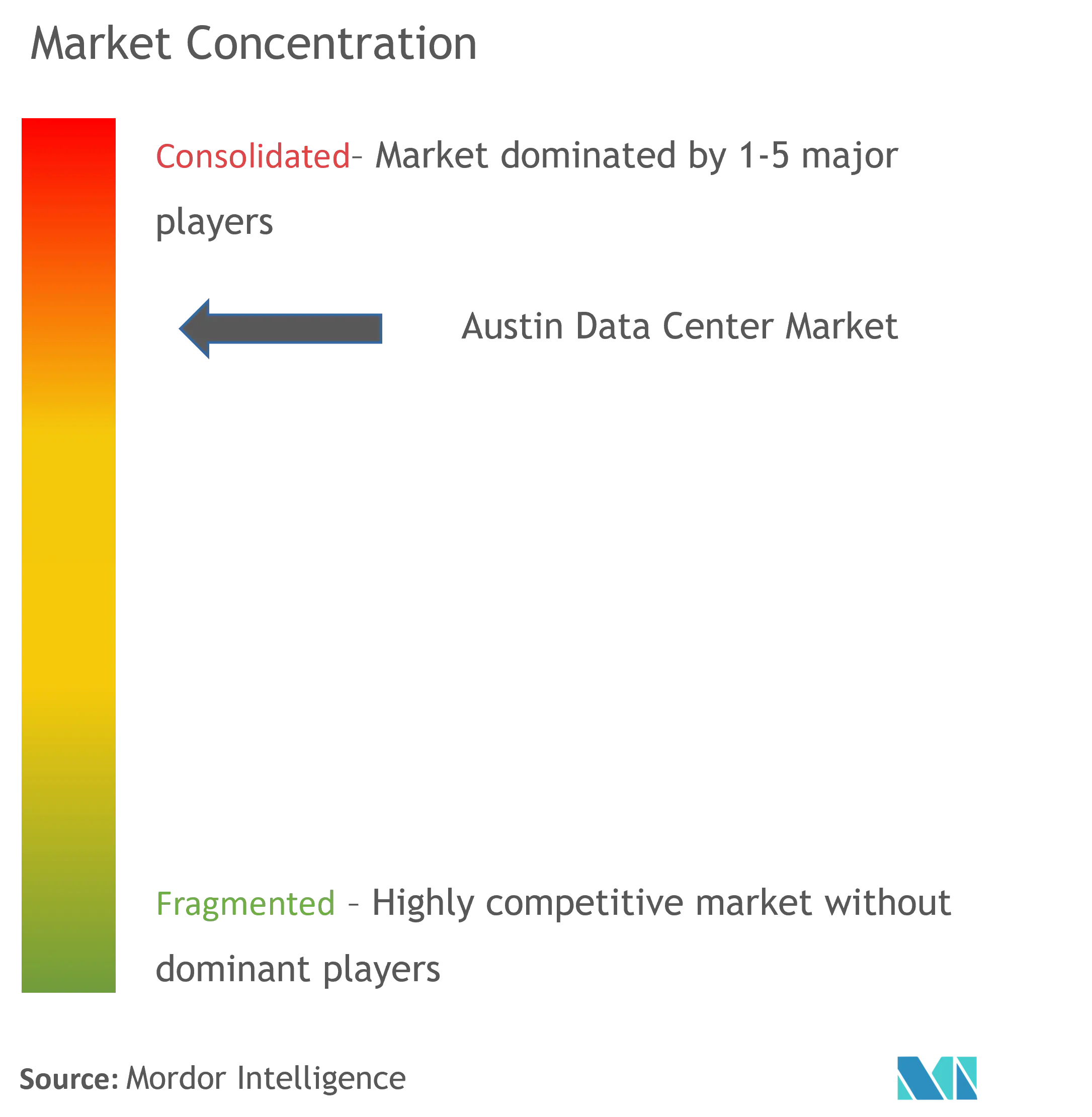
Austin Data Center Market News
- January 2023 : NTT intends to build a new data center in Texas. NTT filed for a new data center dubbed 'TX3 Data Centre' with the Texas Department of Licensing and Regulation (TDLR) . According to the business, the 230,000 square foot (21,350 square metres) facility includes a data center and a two-story office. The corporation intends to invest USD110 million in the project, which is scheduled to start building in March 2023 and finish in April 2024.
- December 2022 : Equinix, Inc., the world's digital infrastructure firm, announced the first pledge by a colocation data centre operator to reduce overall power consumption by increasing operating temperature ranges within its data centres. Equinix will begin defining a multi-year global roadmap for thermal operations within its data centres immediately, aiming for much more efficient cooling and lower carbon footprints while maintaining the premium operating environment for which Equinix is recognized. This programme is expected to help thousands of Equinix customers to reduce the Scope 3 carbon emissions connected with their data centre operations over time, as supply chain sustainability becomes an increasingly essential aspect of today's enterprises' total environmental activities.
Austin Data Center Industry Segmentation
A data center is a physical room, building, or facility that holds IT infrastructure used to construct, run, and provide applications and services and store and manage the data connected with those applications and services.
The Austin Data Center Market is segmented by DC Size (Small, Medium, Large, Massive, Mega), by Tier Type (Tier 1&2, Tier 3, Tier 4), by Absorption (Utilized (Colocation Type (Retail, Wholescale, Hyperscale), End User ( Cloud & IT, Telecom, Media & Entertainment, Government, BFSI, Manufacturing, E-Commerce)) , Non-Utilized).
The market sizes and forecasts are provided in terms of volume (MW) for all the above segments.
| DC Size | Small | |||
| Medium | ||||
| Large | ||||
| Massive | ||||
| Mega | ||||
| Tier Type | Tier 1 & 2 | |||
| Tier 3 | ||||
| Tier 4 | ||||
| Absorption | Utilized | Colocation Type | Retail | |
| Wholesale | ||||
| Hyperscale | ||||
| End User | Cloud & IT | |||
| Telecom | ||||
| Media & Entertainment | ||||
| Government | ||||
| BFSI | ||||
| Manufacturing | ||||
| E-Commerce | ||||
| Other End User | ||||
| Non-Utilized | ||||
Frequently Asked Questions
What is the current Austin Data Center Market size?
The Austin Data Center Market is projected to register a CAGR of 7% during the forecast period (2025-2031)
Who are the key players in Austin Data Center Market?
Digital Realty Trust, Inc., DataBank Ltd, CyrusOne LLC, Switch, Inc. and Sabey Data Center Properties LLC are the major companies operating in the Austin Data Center Market.
What years does this Austin Data Center Market cover?
The report covers the Austin Data Center Market historical market size for years: 2019, 2020, 2021, 2022, 2023 and 2024. The report also forecasts the Austin Data Center Market size for years: 2025, 2026, 2027, 2028, 2029, 2030 and 2031.
Our Best Selling Reports
Austin Data Center Industry Report
Statistics for the 2025 Austin Data Center market share, size and revenue growth rate, created by Mordor Intelligence™ Industry Reports. Austin Data Center analysis includes a market forecast outlook for 2025 to 2031 and historical overview. Get a sample of this industry analysis as a free report PDF download.




